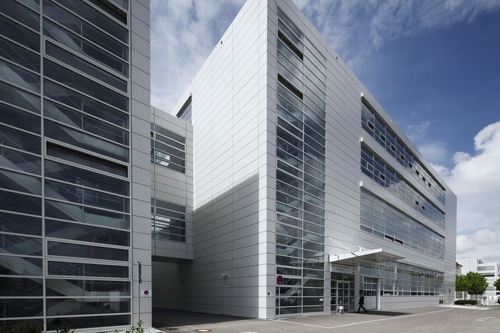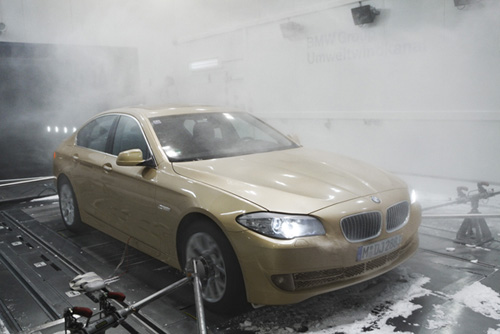The following is a reprint of a great writeup on BMW's ETC, from our friends at
BIMMERFILE.
Their report gives a special look into BMW's state of the art Energy and Environmental Test Center (ETC). It's BMW's willingness to invest in state of the art facilities such as the ETC which allows BMW cars to continue being some of the best engineered cars in the world.
Quote:

BMWs have long enjoyed the reputation of being well built cars that have been exhaustively engineered and tested. And as BMW fans we’ve all seen the photos of a convoy of soon to be released machinery pounding tar in the dead of winter somewhere deep within Finland. However, the problem with all of this testing is that it adds substantially to the development time of a new car and that time is becoming increasingly critical to automakers.
It’s also a detriment to test vehicles out in the open if you’re desperately trying to keep sites like BimmerFile from running photos and descriptions of new models months in advance of their launch.
Finally the other downside to the current testing method; consistency. Whether it’s warm winters in Finland or cool summers in South Africa engineers require consistent conditions to find and solve problems within the myriad of systems within a modern automobile.
Due to all these concerns BMW decided to invest into building a new test facility in Munich that would become the new ground zero for all environmental testing done on new vehicles. Then they did something completely out of the ordinary, they invited us to see it first hand. They escorted us past a parking lot of prototypes with swirly tape (of course we weren’t allow to take photos) and into the very heart of this new facility where we met the engineers and saw the machinery that will shape every new BMW model.
Five test cells form a unique testing center: the new Energy and Environmental Test Centre (ETC) is composed of three thermal wind tunnels— the “climatic wind tunnel”, the “thermal wind tunnel“ and the “environmental wind tunnel” — and two test chambers — the “altitude test chamber” and the “cold test chamber”.
With these five cells all roads and climate zones are under one roof. At the ETC, practically any test can be conducted that used to take place on streets worldwide with cold, heat, sun, rain, snow, air pressure, humidity or wind. Exceptions are driving dynamics tests where vertical forces, lateral dynamics, steering movements and crosswinds are in play.

Cold chamber
Our first stop within the ETC was the Cold Chamber. Naturally it is exactly what you would expect; a huge room that can get down to -30c. However BMW has also added a system that creates airflow replicating a real wind tunnel. It’s more than just temperatures that are tested here as humidity also plays a big part of the real world conditions.
This new testing environment has aided BMW to better design heating systems to warm the various components on the car and also defrost the interior. Creating adequate heating systems has actually gotten harder with the increasingly efficient engines pumping out less wasted heat. In fact one of the biggest challenges they have over the next few years is developing methods for electric cars to start in cold environments while not wasting energy.
BMW expects the facility to ultimately pay for itself due to being able to recoup so much in travel costs (which are over $1,000 a day for remote testing). Of course there will still be testing done in the wild. However, the new cold chamber allows for a level of precision that could never be reached on the open roads.

Acoustic Concepts
Comfort, dynamics and efficiency – these are always in conflict. So the question became: How can BMW increase everything while losing nothing? A tall order but seemingly possible given new technology.
Starting with efficiency BMW has been waging war on weight over the last few years (despite what the scales say when the new 5 series drives on them). But comfort, dynamics and efficiency in ways that may surprise you. For instance the new F01 7 series larger under body does a much better job at absorbing sound while being dramatically lighter than the previous version. This allows for road noise to be drowned out while allowing for appropriate engine noise to come in.
This department also is involved in other more experimental projects, notably the digital interactive sound system concept. The system does several things in an effort to produce a more dynamic engine sound. First it cancels out some of the typical engine noise. Then it produces it’s own engine soundtrack (with the help of several speakers and two subwoofers under the front seats).
The applications are endless but we sampled two. The first was a 630d that was made to sound like a 650i. The second was a MINI with what they call the “sound machine” that could change (on the fly) the engine note to any one of four settings. The system is tied to the engine speed and accurately reproduces engine notes as they are happening.
Does it work? Yes, and very well. Do we like the idea? Absolutely not. Ok, maybe it makes sense for a MINI as a fun option to play with. There is frankly a lack of honesty when you make a diesel sound like a large displacement V8. Nevermind that you can only hear the effects inside the cabin, it’s simply not something we’d ever want a part of.

Wind Tunnels
Inside the ETC BMW has three of the most advanced wind tunnels in the world. The three thermal wind tunnels are identical, but fulfill different requirements, which allows for maximum flexibility in the testing process. They all have a vertical or “standing” air duct; the fan is about 15 metres above the test section — the plenum.
As the engineers told us, BMW takes every car to the extremes of the Earth (or at least where they expect the cars to be drive). That means Death Valley as the lowest spot in the world and Pikes Peak as the highest (with appropriate roads).
Not only do they test airflow but they also test fuel supply, fuel consumption, engine calibration, up hill driving and engine power.
The thermal wind tunnel also serves to ensure thermal operational security. Here, tests are predominantly conducted on cooling performance and air flow. For this reason, temperatures are restricted to the positive range (20 to 45°C). The highest speed at this test bench is 280 km/h.
The environmental wind tunnel covers the greatest bandwidth of environmental conditions. Here, temperatures from minus 20°C to plus 55°C are possible. A solarium can also simulate solar radiation. Rain and snow simulation are also included in the test range. For the first time, a motorcycle flat belt allows for motorcycle tests in an environmental test facility.

Things become even more interesting in the other wind tunnel down the hall. The temperature range of the climate wind tunnel ranges from minus 10°C to plus 45°C. A solarium simulates solar radiation. Here, tests are conducted for thermal management, cooling power and climate control, as well as brake cooling. The especially light and rigid rotary blades of the blower also allow for highly dynamic tests, up to a top speed of 250 km/h.
Not only can BMW test wind flow in high and low temperatures, they can also test it while it snows. For those of us who live with snow in the winter months, we know first hand how it can disrupt engine cooling, accumulate on lights and generally wreak havoc on a car. These facility allows BMW to test all of this in a controlled environment.
One example of their work are the subtle ridges on the corner of the rear lights on some BMW models (F01/07/10 as examples). They are there because research by engineers in this area at the ETC found that this little addition kept snow from forming on the rear lights. It doesn’t sound earth shattering but keeping rear lights visible in a snow storm certainly qualifies as well needed safety. A neat little fact is that there is only one other snow producing wind tunnel of this size in existence in the world and it is designed for use on trains only.
The ETC is an impressive collection of testing facilities and passionate engineers that are driven to make BMW cars better. Through efficiency, safety and performance BMW is once again raising the bar on what is possible in the automotive world. While it’s not sexy or exciting to some, these are the little things that create a compelling ownership experience and truly shows that these details separate BMW from the competition.
|